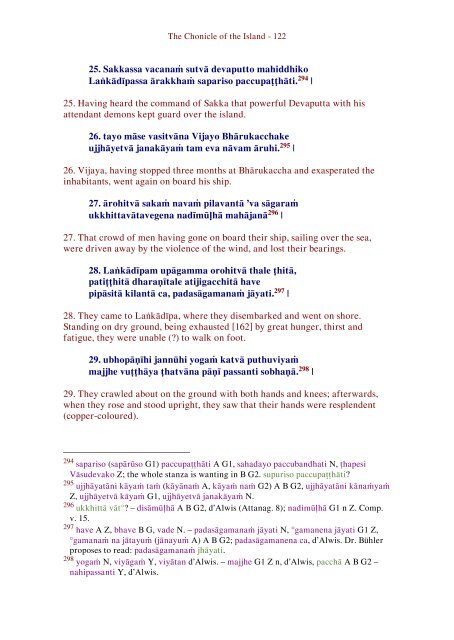Dipavamsa, the Chronicle of the Island
The earliest attempt to write a Chronicle of the Sāsana and the Kings of Sri Lanka, from earliest times up to the 5th c. A.D. Includes both text and translation.
The earliest attempt to write a Chronicle of the Sāsana and the Kings of Sri Lanka, from earliest times up to the 5th c. A.D. Includes both text and translation.
You also want an ePaper? Increase the reach of your titles
YUMPU automatically turns print PDFs into web optimized ePapers that Google loves.
The Chonicle <strong>of</strong> <strong>the</strong> <strong>Island</strong> - 122<br />
25. Sakkassa vacanaṁ sutvā devaputto mahiddhiko<br />
Laṅkādīpassa ārakkhaṁ sapariso paccupaṭṭhāti. 294 |<br />
25. Having heard <strong>the</strong> command <strong>of</strong> Sakka that powerful Devaputta with his<br />
attendant demons kept guard over <strong>the</strong> island.<br />
26. tayo māse vasitvāna Vijayo Bhārukacchake<br />
ujjhāyetvā janakāyaṁ tam eva nāvam āruhi. 295 |<br />
26. Vijaya, having stopped three months at Bhārukaccha and exasperated <strong>the</strong><br />
inhabitants, went again on board his ship.<br />
27. ārohitvā sakaṁ navaṁ pilavantā ’va sāgaraṁ<br />
ukkhittavātavegena nadīmūḷhā mahājanā 296 |<br />
27. That crowd <strong>of</strong> men having gone on board <strong>the</strong>ir ship, sailing over <strong>the</strong> sea,<br />
were driven away by <strong>the</strong> violence <strong>of</strong> <strong>the</strong> wind, and lost <strong>the</strong>ir bearings.<br />
28. Laṅkādīpam upāgamma orohitvā thale ṭhitā,<br />
patiṭṭhitā dharaṇītale atijigacchitā have<br />
pipāsitā kilantā ca, padasāgamanaṁ jāyati. 297 |<br />
28. They came to Laṅkādīpa, where <strong>the</strong>y disembarked and went on shore.<br />
Standing on dry ground, being exhausted [162] by great hunger, thirst and<br />
fatigue, <strong>the</strong>y were unable (?) to walk on foot.<br />
29. ubhopāṇīhi jannūhi yogaṁ katvā puthuviyaṁ<br />
majjhe vuṭṭhāya ṭhatvāna pāṇī passanti sobhaṇā. 298 |<br />
29. They crawled about on <strong>the</strong> ground with both hands and knees; afterwards,<br />
when <strong>the</strong>y rose and stood upright, <strong>the</strong>y saw that <strong>the</strong>ir hands were resplendent<br />
(copper-coloured).<br />
294 sapariso (sapārūso G1) paccupaṭṭhāti A G1, sahadayo paccubandhati N, ṭhapesi<br />
Vāsudevako Z; <strong>the</strong> whole stanza is wanting in B G2. supuriso paccupaṭṭhāti?<br />
295 ujjhāyatāni kāyaṁ taṁ (kāyānaṁ A, kāyaṁ naṁ G2) A B G2, ujjhāyatāni kānaṁyaṁ<br />
Z, ujjhāyetvā kāyaṁ G1, ujjhāyetvā janakāyaṁ N.<br />
296 ukkhittā vāt°? – disāmūḷhā A B G2, d’Alwis (Attanag. 8); nadimūḷhā G1 n Z. Comp.<br />
v. 15.<br />
297 have A Z, bhave B G, vade N. – padasāgamanaṁ jāyati N, °gamanena jāyati G1 Z,<br />
°gamanaṁ na jātayuṁ (jānayuṁ A) A B G2; padasāgamanena ca, d’Alwis. Dr. Bühler<br />
proposes to read: padasāgamanaṁ jhāyati.<br />
298 yogaṁ N, viyāgaṁ Y, viyātan d’Alwis. – majjhe G1 Z n, d’Alwis, pacchā A B G2 –<br />
nahipassanti Y, d’Alwis.

















